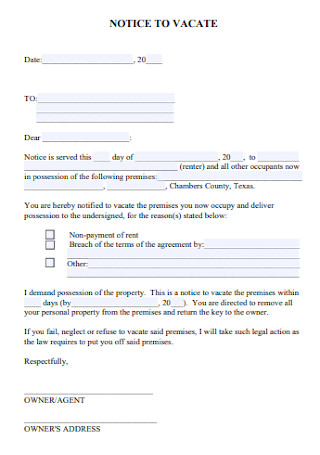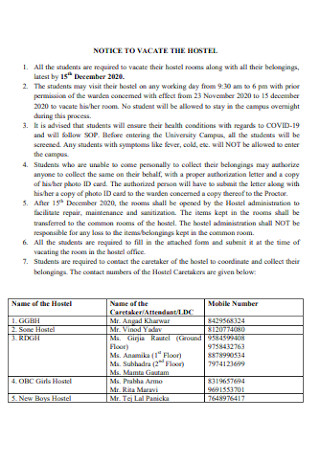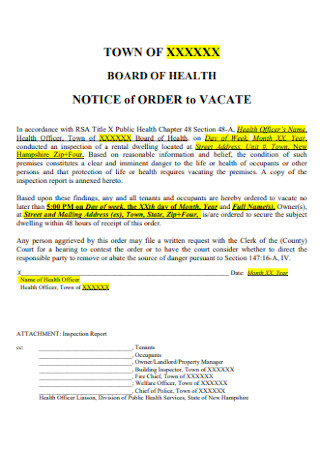Notice to Vacate Samples
-

Tenant Notice to Vacate Template
download now -

Sample Notice to Vacate
download now -

Notice to Vacate PDF
download now -

Notice to Vacate Apartment
download now -

Sample Notice to Vacate
download now -

60 Day Notice to Vacate
download now -

30 Day Notice to Vacate
download now -

Notice to Vacate Eviction Form
download now -

Thirty Day Notice to Intent Vacate
download now -

Notice to Correct or Vacate
download now -

Improper Notice to Vacate
download now -

Notice to Pay or Vacate Notice
download now -

Serving Notice to Vacate
download now -

Apartment Notice to Vacate
download now -

Receipt of Notice To Vacate
download now -

Request Extension of Notice to Vacate
download now -

Notices to Vacate and Ending a Lease
download now -

Tenant Notice to Vacate Letter
download now -

Notice to Vacate for Failure
download now -

Notice of Intent to Vacant
download now -

Properties Notice to Vacate
download now -

Housing Office Notice to Vacate
download now -

Giving Your Tenant Notice to Vacate
download now -

Simple Notice to Vacate
download now -

Notice Pay Rent or Vacate
download now -

Notice to Vacate for Non Payment Rent
download now -

Self Storage Notice to Vacate
download now -

Day Notice to Vacate Apartment
download now -

Notice to Vacate Agreement Form
download now -

Notice to Vacate Policy Template
download now -

Notice to Vacate Packet Cover Sheet
download now -

Official Notice to Vacate Form
download now -

Resident Notice to Vacate
download now -

Notice-To-Vacate Letter Checklist
download now -

Hostel Notice to Vacate
download now -

Parking Tenant Notice to Vacate
download now -

Resident Notice of Vacate
download now -

Board of Health Notice to Vacate
download now -

Notice to Vacate for Nonpayment of Rent
download now -

Notice to Vacate from Mortgagee
download now -

Cancellation of Notice to Vacate
download now -

Organ Notice to Vacate
download now -

Notice to Vacate Rental Unit
download now -

Notice to Vacate Agreement Template
download now -

Unlawful Notice to Vacate
download now -

Notice to Vacate and Surrender Possession
download now -

Notice to Vacate for Hostel Room
download now -

Forest Notice to Vacate
download now -

Official Notice of Intent to Vacate
download now
FREE Notice to Vacate s to Download
Notice to Vacate Format
Notice to Vacate Samples
What is Notice to Vacate?
The Basic Components of a Notice to Vacate
How to Process a Notice to Vacate
What are other names of a notice to vacate?
Is a notice to vacate still needed if you break a lease?
Is it okay to just talk with the landlord about moving out?
When is a Notice to Vacate Needed?
What to Know About a Notice to Vacate
What’s the Difference Between a Notice to Vacate, a Lease Termination Letter, and Termination of Tenancy?
When Should I Use a Notice to Vacate?
What is a 5 Day Notice to Vacate in California?
What Happens After 30 Day Notice to Vacate in Texas?
How Must Notice to Vacate Be Delivered in Texas?
Can you pay rent after notice to vacate Texas?
What does a notice to vacate mean in Texas?
How do I stop a notice to vacate in California?
How long can a tenant stay without paying rent in California?
Can you be evicted if you pay partial rent in Texas?
What is the minimum notice to vacate in Michigan?
Can a landlord evict you immediately in Michigan?
Download Notice to Vacate Bundle

Notice to Vacate Format
[Your Name]
[Your Address]
[City, State, ZIP Code]
[Email Address]
[Phone Number]
[Date]
[Landlord’s Name]
[Landlord’s Address]
[City, State, ZIP Code]
Subject: Notice to Vacate
Dear [Landlord’s Name],
I am writing to inform you of my intention to vacate the premises at [Rental Property Address] effective [Move-Out Date].
Details:
- Reason for Vacating: [Brief explanation]
- Forwarding Address: [Your new address]
Please let me know the procedures for the return of my security deposit. Thank you for your cooperation.
Sincerely,
[Your Name]
What is Notice to Vacate?
A Notice to Vacate is a written statement by a tenant or landlord indicating the intention to end a rental agreement. This notice is typically required to be given within a specific timeframe, often 30 days, depending on the lease terms and local laws. It serves as an official communication to inform the other party about the planned move-out date and any necessary actions to be taken before vacating the property.
According to Statista’s 2017 research survey, 77.3% of American respondents agreed that the leading cause for renters receiving eviction notices was due to nonpayment.
Also, it is generally known that a notice to vacate is required for rentals of any period, particularly if your lease already has an end date.
Why Is a Notice to Vacate Important?
A notice to vacate letter or form is essential so tenants can send an official notification to their landlords that they intend to vacate the rented property in the future. It is naturally sent around 30-60-90 days early so the landlord or the tenant can find a replacement for who gets to stay at the premises once vacated. Also, it is needed to submit first or the tenant might face an expensive lawsuit or security deposit without informing the landlord about moving out. In fact, Apartment Guide said that the notice to vacate is required for rentals of any schedule, especially if the lease has an end date already.
Besides the intent of a tenant to move out, sometimes submitting it is required if the tenant himself/herself committed a lease violation. An example is due to nonpayment, which has been reported that in 2017, 77.3% of respondents in America agreed that nonpayment was the top cause for renters to receive eviction notices. Hence, violators may be forced to vacate the premises, and providing the notice is still important in doing so.
The Basic Components of a Notice to Vacate
While you already know the notice to vacate’s definition and importance, it is time to familiarize what the common elements are found inside this notice in the first place. Indeed, the notice’s content may differ from one example to another. But generally, a notice to vacate’s components consist of the following:
How to Process a Notice to Vacate
Are you ready to make your own notice to vacate? From everything you learned from the discussion earlier, you are clearly ready to craft the said document. In fact, it gets easier when you base on the sample templates provided above this article. And it couldn’t get any easier as you follow these six steps on how to process your own notice to vacate shortly:
Step 1: Review the Lease Agreement
First of all, it is crucial that you review the original rental or lease agreement. Reviewing helps you see the requirements on how to move out. While it is standard that 30-day notices are expected, some landlords may need you to prepare at least 60 or 90 days prior. Also, you can check from the agreement how much security deposit will be received and other regulations to observe until you finally move out peacefully and legally from the premises.
Step 2: Download a Sample Notice to Vacate
To start putting your notice into writing, download from any of the sample notice to vacate templates listed above. Samples make the process easier for you since the rest of the components, format, and details are already premade. Hence, you only need to provide additional details and customize according to how you want the notice to look. In fact, every sample is easy to edit, download, and print—promising you a convenient and quick experience to produce such notices.
Step 3: Add the Important Components in the Notice
You are already familiar with the basic components of a notice to vacate, as previously discussed. Thus, add each component that is relevant to your document. From the date down to the forwarding address, ensure that you have inserted them into the notice. The best part is that such components are already a smart way to organize the details in the document. Each component represents a clause or section of your notice, making it an easy-to-follow structure.
Step 4: Set a Polite Tone
Upon writing notices, always be cordial or polite. Planning to move out should leave a positive message rather than ending things badly. There is no need to write about unnecessary complaints of your stay in the apartment or threats to the landlord. In fact, impolite messages may only drive the landlord to reject your letter, making it more difficult to move out. Think as if you are writing a formal letter rather than being too personal though.
Step 5: Keep It Detailed yet Straightforward
Balance the concept of giving detailed but straightforward information. Landlords don’t have time to read lengthy messages that could have been shortened if they were direct to the point. More so, don’t do it to the point where it is too short that it lacks the details and significant parts. The key is to write only what is asked. Or perhaps, just write about the crucial components of a notice to vacate. If it is brief, solid, and easy to understand, then it is good to go.
Step 6: Finalize the Notice’s Format and Submit
Be sure to finalize the notice to vacate’s format, design, and output before actually submitting it. You can go for a printed copy to send to the landlord personally or just send it via email. You only do that if you are sure that the details are error-free; otherwise, problems might pop up. And if you are confident enough with its output, you are ultimately ready to submit it.
What are other names of a notice to vacate?
A notice to vacate can sometimes be referred to as a notice of intent to vacate, intent to vacate letter, or a move-out notice.
Is a notice to vacate still needed if you break a lease?
Yes, preparing a notice to vacate is necessary even when you have broken a lease agreement. An example is when you were given an eviction notice due to a certain violation. There may be fees to settle upon leaving to fix the issue but a notice to vacate is still relevant to set the formal time frame of when you shall move out.
Is it okay to just talk with the landlord about moving out?
Yes, talking with the landlord is even recommended to be done first before writing the notice to vacate. However, a written notice to vacate is still important to have official documentation that you followed the requirements in terminating a lease. Consider the documented record as your protection in case things head to court between you and your landlord.
When is a Notice to Vacate Needed?
A Notice to Vacate is needed when either a tenant or landlord decides to end a rental agreement.
Key Situations:
- End of Lease Term: When the lease term is coming to an end and the tenant or landlord does not wish to renew.
- Breaking the Lease: If a tenant needs to move out before the lease term ends, a notice to vacate is required.
- Rent Non-Payment: Landlords may issue a notice to vacate if the tenant fails to pay rent.
- Lease Violations: Breach of lease terms by the tenant, such as unauthorized pets or subletting.
- Property Sale: Landlords may need tenants to vacate if they sell the property.
A Rent Notice can also be used to inform tenants of upcoming rental payments and ensure they are aware of their obligations under the lease agreement.
What to Know About a Notice to Vacate
Understanding a Notice to Vacate is essential for both tenants and landlords.
Essential Points:
- Legal Requirements: Each state has specific laws governing how and when a notice must be given.
- Timeframes: Notices typically require 30, 60, or even 90 days, depending on the lease and local laws.
- Format: Notices should be in writing and include specific information such as move-out date and reasons.
- Delivery Methods: Some states require personal delivery, certified mail, or posting on the property.
- Responses: Tenants should respond promptly, and landlords should keep documentation of all notices.
In certain cases, a Two Weeks Notice might be required, especially for shorter-term lease agreements or specific lease conditions.
What’s the Difference Between a Notice to Vacate, a Lease Termination Letter, and Termination of Tenancy?
Understanding the differences can help clarify legal obligations and processes.
Key Differences:
- Notice to Vacate: A statement from tenant or landlord to end the lease, typically needing a specified notice period.
- Lease Termination Letter: A formal document ending the lease agreement, often mutually agreed upon by both parties.
- Termination of Tenancy: This can be a broader term encompassing both notices and terminations, including evictions for cause.
- Work Notice: Work Notice used in a workplace context to notify about changes in work status, distinct from rental notices.
- University Notice: University Notice specific to university housing, often requiring different procedures and notice periods.
When Should I Use a Notice to Vacate?

A Notice to Vacate should be used under specific circumstances requiring the end of a tenancy.
Appropriate Times:
- Lease Expiration: When approaching the end of a lease term and not planning to renew.
- Job Relocation: Moving to a new location due to a job change or transfer.
- Property Issues: Habitability issues, such as significant repairs or unsafe conditions.
- Personal Reasons: Family emergencies, health issues, or changes in personal circumstances.
- Restaurant Notice: For commercial tenants, like restaurants, needing to end a lease due to business changes. You may also see Tenant Notice
What is a 5 Day Notice to Vacate in California?
In California, a 5 Day Notice to Vacate is typically used in specific situations requiring urgent action.
Key Aspects:
- Non-Payment of Rent: Often issued when a tenant fails to pay rent and must vacate within five days.
- Lease Violations: Serious breaches of the lease agreement, such as illegal activities.
- Health and Safety: Immediate threats to health or safety requiring quick vacating.
- Eviction Process: Initiating the formal eviction process with a short notice period.
- University Notice: Sometimes relevant in university housing for urgent move-outs. You may also see Restaurant Notice
What Happens After 30 Day Notice to Vacate in Texas?
After issuing a 30 Day Notice to Vacate in Texas, certain steps follow for both tenant and landlord.
Subsequent Steps:
- Vacate the Property: Tenant must move out by the specified date on the notice.
- Final Inspection: Landlord inspects the property for damages and cleanliness.
- Security Deposit: Tenant may receive the security deposit back, minus any deductions.
- Legal Action: If tenant fails to vacate, landlord may initiate legal eviction proceedings.
- Freelancer Notice: Freelancer Notice is relevant for freelancers using rented office spaces, similar to residential lease terminations.
How Must Notice to Vacate Be Delivered in Texas?
In Texas, delivering a Notice to Vacate must comply with state regulations to be legally effective.
Delivery Methods:
- Personal Delivery: Handing the notice directly to the tenant.
- Mail: Sending via certified mail to ensure proof of delivery.
- Posting: Affixing the notice to the inside of the main entry door.
- Electronic Delivery: Some leases may allow notices via email if previously agreed upon.
- Employee Notice: Employee Notice is similar procedures may apply in employment contexts, ensuring proper delivery of important notices.
Can you pay rent after notice to vacate Texas?
In Texas, you can pay rent after receiving a notice to vacate, but it doesn’t necessarily cancel the Warning Notice unless the landlord agrees to rescind it.
What does a notice to vacate mean in Texas?
A notice to vacate in Texas is a formal demand from the landlord for the tenant to leave the property, often due to lease violations or end of lease term, similar to a Copyright Notice.
How do I stop a notice to vacate in California?
To stop a notice to vacate in California, you must comply with the landlord’s demands, negotiate a settlement, or address the issues causing the notice, similar to responding to a Late Rent Notice.
How long can a tenant stay without paying rent in California?
In California, a tenant can stay without paying rent until the landlord issues a Three-Day Notice to pay or quit. Failure to comply can lead to an Eviction Notice.
Can you be evicted if you pay partial rent in Texas?
Yes, in Texas, paying partial rent can still result in eviction. Landlords may issue a Day Notice to vacate if the full rent is not paid. You may also see Past Due Rent Notice
What is the minimum notice to vacate in Michigan?
The minimum notice to vacate in Michigan is generally a 30-Day Notice for month-to-month leases, ensuring tenants have adequate time to relocate.
Can a landlord evict you immediately in Michigan?
A landlord cannot evict you immediately in Michigan; they must follow legal procedures, including providing a Seven-Day Eviction Notice for lease violations or a Week Notice for nonpayment of rent.
In conclusion, whether you are a tenant or a landlord, understanding the Notice to Vacate process is crucial for a smooth transition in Standard Tenancy Agreement. This guide provides you with sample notices, forms, and letters to make the process straightforward and hassle-free. Using these resources ensures you meet all legal requirements and communicate effectively. Properly handling a notice to vacate can help avoid conflicts and misunderstandings, making the move-out process easier for everyone involved. Make sure to follow the guidelines and use the provided templates to draft your notice correctly.

